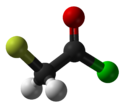Chemistry:Fluoroacetyl chloride
From HandWiki
|
| |||
| Names | |||
|---|---|---|---|
| Preferred IUPAC name
Fluoroacetyl chloride | |||
| Other names
2-Fluoroacetyl chloride
Fluoroethanoyl chloride | |||
| Identifiers | |||
| |||
3D model (JSmol)
|
|||
| ChemSpider | |||
PubChem CID
|
|||
| UNII | |||
| |||
| |||
| Properties | |||
| C2H2ClFO | |||
| Molar mass | 96.49 g·mol−1 | ||
| Boiling point | 70 to 71 °C (158 to 160 °F; 343 to 344 K) at 755 mmHg[1] | ||
| Hazards | |||
| NFPA 704 (fire diamond) | |||
Except where otherwise noted, data are given for materials in their standard state (at 25 °C [77 °F], 100 kPa). | |||
| Infobox references | |||
Tracking categories (test):
Fluoroacetyl chloride is an acyl chloride.
In 1948, William E. Truce of Purdue University described a synthesis of fluoroacetyl chloride which was undertaken "because of its potential value for introducing the group, —COCH2F, into organic molecules."[1] In this synthesis, he reacted sodium fluoroacetate with phosphorus pentachloride to obtain the desired compound.
See also
References
- ↑ Jump up to: 1.0 1.1 Truce, William E. (August 1948). "The Preparation of Fluoroacetyl Chloride". Journal of the American Chemical Society 70 (88): 2828. doi:10.1021/ja01188a524.
 |




